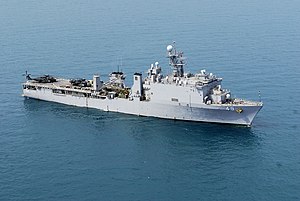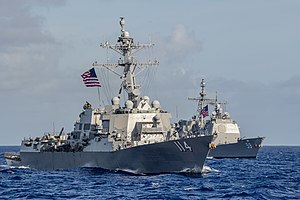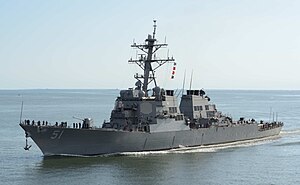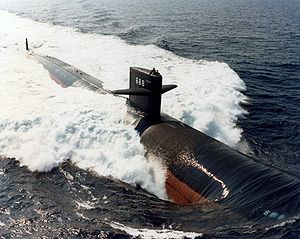Riamese Navy: Difference between revisions
mNo edit summary |
No edit summary |
||
| Line 126: | Line 126: | ||
===Patrol Cruisers=== | ===Patrol Cruisers=== | ||
Originally designated as "Heavy Escort Seaplane tenders" | Originally designated as "Heavy Escort Seaplane tenders", the Patrol Cruisers were a series of vessels whose main characteristic was their Hawville catapult located between the funnels, which allowed them to carry multiple planes on board. The 1933 Defiant Class served as testament, almost by mistake, of the great power that held having a deployable torpedo bomber on board. 1936 would see the appearance of the Seahawk Class, which was able to carry 6 planes on board, from which 2 were redeployable torpedo bombers, albeit with the cost of primary armament firepower. | ||
Fury Class would come in 1939 followed by the D-Class of 1944, which were capable of carrying up to 8 squeezed planes in total. These late Patrol Cruisers allowed for the usage of reconaissance planes without the need of seaplane tenders or aircraft carriers, which would have been costly and have limited severely the efforts of the [[Riamese Navy]] throughtout the decade of the 1930s. | |||
<!-- | <!-- | ||
| Line 135: | Line 137: | ||
==Assets== | ==Assets== | ||
--> | --> | ||
==Assets== | |||
{| class="wikitable" style="width:100%;" | {| class="wikitable" style="width:100%;" | ||
| Line 160: | Line 163: | ||
|Helicopter Carrier <br> (Support and Helicopter Training) <br> {{flag|Riamo}} | |Helicopter Carrier <br> (Support and Helicopter Training) <br> {{flag|Riamo}} | ||
|[[File:RFA_Argus_off_the_coast_of_Devonport.jpg|center|300px]] | |[[File:RFA_Argus_off_the_coast_of_Devonport.jpg|center|300px]] | ||
| | | | ||
* RRN Trident | * RRN Trident | ||
| ''Unique merchant conversion, Landing Ship Dock'' | | ''Unique merchant conversion, Landing Ship Dock'' | ||
She was inaugurated by Queen Diana herself as a command & humanitarian aid ship, later being in several natural disasters helping people globally, slowly becoming a national symbol of Riamo amongst its people. | |||
|- | |- | ||
| Liberty Class <br> Destroyers <br> {{flag|Riamo}} <br> {{flag|Hoterallia}} <br> {{flag|Qazhshava}} | | Liberty Class <br> Destroyers <br> {{flag|Riamo}} <br> {{flag|Hoterallia}} <br> {{flag|Qazhshava}} | ||
Revision as of 22:09, 16 September 2021
This article is incomplete because it is pending further input from participants, or it is a work-in-progress by one author. Please comment on this article's talk page to share your input, comments and questions. Note: To contribute to this article, you may need to seek help from the author(s) of this page. |
| Royal Riamese Navy | |
|---|---|
| Founded | 9 June 1719 |
| Website | www.armedforces.gov.ri |
| Personnel | |
| Military age | 18 |
| Industry | |
| Foreign suppliers | |
| Annual exports | |
The Riamese Navy is the naval component of the Riamese Armed Forces. Her duties include protecting Riamese and regional diplomatic, economical, and social interests, as well as providing an offensive and defensive force capable of defending the nation and its peoples.
Role
Functions of the defense force include:
- Defend national interests of Riamo
- Assisting in labors of national security as well as during environmental disasters
- Affirming Riamese position as a leading naval power
- Project a sense of security to the nations with economical, cultural, historical and political ties to Riamo
- Humanitarian Aid and Peacekeeping
Riamo has no separation between navy, coast guard, sea police or anything alike, being the navy the force that encompasses all roles coast guard would also cover in traditional countries.
History
Pre-colonial times
Before the dawn of the Empire the Riamese fleet was mostly composed of smaller trading vessels, with Speer, Butter and Linghtings being common sights. The vast majority of the wartime fleet was not owned by the monarch but rather medieval lords, whose ships would be called to assist the king in case of war but were allowed to operate with normality otherwise.
By the late 14th century, the invention of the Galtiner as an exploration ship allowed Riamese adventurers to start discovering lands far from Metropolitan Riamo, while others like the Portington spread around Guri and the central coast as an efficient armed attack sailing ship.
Empire
By the 16th century, explorers had managed to expand Riamese influence over the waves, with colonies eventually sparkling across and around the Talsar Ocean with massive incentives from the crown. Ships like the Double Galtiner and the Portington were popularized throughout the empire by this time, and would become the backbone of the navy for years to come.
Larger ships like the Tripple would allow for farther exploration by the 17th century, allowing for the colonization of Freice and Gassassinia, among others. It would be variations of the Tripple that helped put Riamese ships at par with the rest of the eastern kingdoms.
Modern Era
Tall masted wooden vessels would soon be phased out for newer ships by the late 19th century, with cruisers being caught first by the wave of armoured shipbuilding. All first Riamese attempts at armoured shipbuilding proved futile, most including some combination of masts and engines with wood and metal while usually including less than half the safe boats needed for embarking their full crews. By the 1880s sails had proved counterproductive when combined with boilers, being phased out in the Riamese and Neuew navies by 1885.
Armoured & Protected Cruisers
Armoured cruisers would appear in the mid 1880s, featuring am armoured belt on the waterline protective against most direct hits to the broadside, but would soon be proven ineffective against the ever-advancing high penetration projectiles that were appearing by the dawn of the 20th century.
They would be closely followed by the protected cruisers, featuring an internal armoured deck that covered the vital parts and citadel at an angle, increasing effectiveness in relation to thickness, some still proving useful by the late 1920s.
Dreadnoughts
By the dawn of the 20th century it had become obvious that armoured ships were the future. Steam and turrets had replaced wind and cannons, and ships were now truly expensive and heavy. By then ships had multiple calibres that made it hard to guess which splash came from which gun, making the aiming process difficult, reason why Riamese naval engineer Dreadnought envisioned a single calibered armoured ship with 5 turrets. His idea would be quickly adopted by the naval powers of Riamo and Neuewland. Having put afloat the first Dreadnought battleships by 1903, the former would make quick development of engines and turrets, while the latter would pioneer superfiring turrets by 1905. It would take years for most other naval powers to commit to the concept.
Although not the first one laid down, RRS Elizabeth was the first Charles Class Battleship to be commissioned. She pioneered the tripod mast design, inspired by Neuew's latest dreadnought classes, which would revolutionize Riamese naval construction after 1906.
By 1908 came the iconic Majestuous Class of the Riamese Navy, Protected Cruisers with a tripod main mast and 5 turrets which would settle the grounds for the second generation of Riamese Dreadnought Battleships. The Majestuous would also show the advantages of not having uniform armour thickness across the ship, helping with manoeuvrability and speed.
Second Generation Dreadnoughts
1911 saw the dawn of the Furious Class Battleships, which stepped down to 4 main turrets and kept Dreadnought's 2 mast configuration. Furious was the first ship to have an armour belt that did not cover the entire ship's length. This generation was short but proved the effectiveness of uneven armour and superstructures on ships, while proving wrong previous assumptions around efectiveness of casemate guns.
Third & Fourth Generation Dreadnought Battleships
Third generation ships came lead by Blackwood Class in 1916, reintroducing the tripod mast design. Casemates would be utterly abandoned in favor of mounts, which proved effective at providing extra firepower against casemates' reduced firing arches and tightness of spaces. This generation pioneered the island-type superstructure and most ships would remain on service for decades.
The fourth generation was born by the 1930s, with ships like the Trident and Longsword demonstrating the efficiency of having great calibered guns mixed with anti-air and anti-ship secondary armament around the superstructure. This generation would aim for slimmer vessels and more decentralized superstructures that could feature as many mounts with frontal firing arches as possible.
Light Cruisers
The so-called Light Cruisers would be born as lighter versions of Armoured Cruisers by the 1900s. Mostly meant for escort, spotting and patrol duties, they would soon be popularized. The idea would stay afloat past the Battleship period, with a generational change between the 1920s-30s, time by when the concept evolved to cover fleet needs and trade protection roles.
Cruisers by the 1930s usually presented a combination of good speed, manoeuvrability, torpedo armament, and plane launching systems, in exchange for lower armour and firepower than Battleships of the era.
Spotting Cruisers
The Spotting cruisers were an unofficial branch of Riamese cruisers lead by the defiant
RRN Albion
Built as the first ship officially designated as a Heavy Cruiser, the Albion Class was developed following lessons learnt from lighter escort cruisers like the Gassassinia Class, which lacked in firepower and armour in expense for speed, manoeuvrability and AA-gunnery. She would be planned to hold sustainable amounts of firepower for her displacement while keeping a relatively high cruising speed and acceptable armour. Topped with 4x triple 6-inch turrets and a plane catapult, she was expected to be the first of a class that would cover most flotilla leader capabilities while providing firepower needed on most trade-raiding engagements.
Albion & Defiant
By November 1932, the admiralty had received several reports regarding the poor reconnaissance and firepower capabilities of most previous cruiser classes, including the Albion Class, which would often force the usage of battleships as part of escort flotillas. This void sparkled the creation of the Defiant Class of Heavy Cruisers off of HMS Defiant, former member of the Albion Heavy Cruiser Class.
By their commissioning, the 2 now former sister ships were unrecognizable. Albion, which had been redesigned to meet the AA-battery & support roles, now varied vastly from Defiant, modified to have a Hawville-designed state-of-the-art catapult system which gave her capacity for 4 planes, including a torpedo bomber, as well as an extended delta-type command deck and Mk7 radar system. RRS Defiant would be the only ship of the Royal Navy to be part of 2 different classes upon being laid down.
Patrol Cruisers
Originally designated as "Heavy Escort Seaplane tenders", the Patrol Cruisers were a series of vessels whose main characteristic was their Hawville catapult located between the funnels, which allowed them to carry multiple planes on board. The 1933 Defiant Class served as testament, almost by mistake, of the great power that held having a deployable torpedo bomber on board. 1936 would see the appearance of the Seahawk Class, which was able to carry 6 planes on board, from which 2 were redeployable torpedo bombers, albeit with the cost of primary armament firepower.
Fury Class would come in 1939 followed by the D-Class of 1944, which were capable of carrying up to 8 squeezed planes in total. These late Patrol Cruisers allowed for the usage of reconaissance planes without the need of seaplane tenders or aircraft carriers, which would have been costly and have limited severely the efforts of the Riamese Navy throughtout the decade of the 1930s.
Assets
| Name | Image | Ships | Notes | |
|---|---|---|---|---|
| Surface Combatants | ||||
| Triumphant Class Amphibious Assault Ships (Landing Helicopter Dock) |
|
|||
| Diana Class Amphibious Assault & Medical Assistance Ship |
|
|||
| Helicopter Carrier (Support and Helicopter Training) |
|
Unique merchant conversion, Landing Ship Dock
She was inaugurated by Queen Diana herself as a command & humanitarian aid ship, later being in several natural disasters helping people globally, slowly becoming a national symbol of Riamo amongst its people. | ||
| Liberty Class Destroyers |
|
Sometimes called "Guri-B Class", the Libertad Class is a never version of the Guri Class with changes in configuration and design. All units but Qazhshavan ones have the Riamese-Vultesian designed Trident Combat System | ||
| Guri Class Destroyers |
|
Sometimes called "Guri-A Class", the Guri Class Destroyers are the first series to include the Riamese-Vultesian designed Trident Combat System | ||
| Albert Jhonson Class Litoral Patrols |
|
|||
| Delta Class Frigates |
|
Mostly used as light coastal patrol | ||
| Thunder Class Litoral Patrols |
Batch 2:
|
Co-developed by Sister of Seabird Class | ||
| Yankee Class Minehunters |
|
Co-developed by | ||
| Monarch Class Corvettes |
|
|||
| Queensboro Class Assault Submarines |
|
|||
| Auxiliary Ships | ||||
| Mercy Class Hospital Ships |
|
|||
| Cape June Class At-sea-replenishment Ships |
|
|||
| Sundancer Class Hidrographic Vessels |
|
|||
| Independence Class Oceanographic Vessel |
|
|||













